Welcome back to guitarplayers.net! As your dedicated guide in the world of guitar mastery, we often encounter aspiring musicians puzzled by fundamental concepts. Today, we’re demystifying two crucial elements in guitar playing and songwriting: guitar riffs and licks. It’s surprising how many guitarists struggle to distinguish, or even define, these essential terms.
If you find yourself unsure about the difference, don’t worry; you’re in good company. However, a clear understanding of riffs and licks is vital. Without it, composing your own music or effectively communicating your musical ideas to fellow musicians becomes unnecessarily challenging.
That’s why we’re here to set the record straight. This comprehensive guide will equip you with the knowledge to confidently differentiate between a guitar riff and a lick, empowering your musical journey.
Throughout this lesson, we’ll explore captivating guitar riffs and licks, complete with tablature examples to get you started. To truly grasp their essence and style, we highly recommend listening to the original recordings of the songs mentioned. Immerse yourself in the context and feel the music as it was intended.
So, let’s dive into the captivating world of guitar riffs and licks, and clear up any confusion once and for all!
 A guitarist passionately playing an electric guitar, focused on the fretboard, fingers moving swiftly.
A guitarist passionately playing an electric guitar, focused on the fretboard, fingers moving swiftly.
What is a Guitar Riff? The Musical Hook Explained
Let’s cut to the chase. A guitar riff is the DNA of a song. It’s a concise, repeating musical phrase or motif that forms the backbone and identity of a song. Think of it as a catchy musical idea, often introduced early in the song, particularly in the intro, that immediately grabs the listener’s attention and establishes the song’s character.
Remember the legendary intro to Guns N’ Roses’ “Sweet Child O’ Mine,” masterfully crafted by Slash? That instantly recognizable melodic pattern, as iconic as the song itself, is a quintessential guitar riff. It’s one of the most globally recognized musical phrases in guitar history. That is a prime example of a guitar riff.
 Close-up of guitar strings being strummed, highlighting the rhythmic and melodic aspect of a guitar riff.
Close-up of guitar strings being strummed, highlighting the rhythmic and melodic aspect of a guitar riff.
The Power and Purpose of Guitar Riffs
Why are guitar riffs so crucial? A well-crafted riff elevates a simple song into something truly unforgettable. This core musical theme remains consistent throughout the song, acting as a sonic signpost, instantly informing listeners what song they are hearing. It provides a sense of familiarity and anchors the song’s structure.
Imagine attempting to play Led Zeppelin’s “Stairway to Heaven” with a completely different opening. It simply wouldn’t resonate the same way. Why? Because that iconic opening riff is the very essence, the soul, of “Stairway to Heaven.” It’s integral to the song’s identity and emotional impact.
Similarly, if you were to strip away the instantly recognizable and spine-tingling riff from Deep Purple’s “Smoke on the Water,” the song would lose its immediate impact and much of its power. The riff is the driving force, the catchy element that makes it instantly recognizable and memorable.
Throughout music history, countless guitarists have harnessed their creativity to forge riffs that have not only topped charts but have also endured for decades, becoming timeless classics. These riffs are the building blocks of rock, blues, and many other genres, demonstrating their enduring power.
Must-Hear Guitar Riffs: A Starting Point
To illustrate the impact of riffs, explore this curated list of some of the greatest riffs ever conceived. We’ll revisit more later, but this is a fantastic starting point:
- “Voodoo Child (Slight Return)” – Jimi Hendrix (A masterclass in psychedelic blues-rock riffing)
- “Beat It” – Michael Jackson (Eddie Van Halen’s iconic riff fusion into pop)
- “Alphabet Street” – Prince (Funky and rhythmically infectious riff)
- “No One Knows” – Queens of the Stone Age (Hypnotic and driving desert rock riff)
- “Killing In the Name” – Rage Against the Machine (Aggressive and politically charged riff)
- “Satisfaction” – The Rolling Stones (Fuzzy and timeless rock and roll riff)
- “Seven Nation Army” – The White Stripes (Deceptively simple yet incredibly powerful riff)
- “Hero” – Skillet (Modern rock anthem with a strong, driving riff)
 A collage of album covers featuring artists known for iconic guitar riffs, such as Jimi Hendrix, The Rolling Stones, and AC/DC.
A collage of album covers featuring artists known for iconic guitar riffs, such as Jimi Hendrix, The Rolling Stones, and AC/DC.
Guitar Riffs: The Heartbeat of a Song
Hopefully, you now have a solid grasp of what a guitar riff truly is. It’s the musical heartbeat of a song, establishing a thematic foundation and typically gracing the song’s introduction—though riffs can be strategically placed throughout a track for emphasis and structure.
Feel empowered to compose your own riffs and experiment with their placement within your musical creations. Remember, a riff should be a concise musical phrase or a series of phrases that defines your song’s identity, adding depth and memorability.
Don’t feel pressured to improvise over your own riffs; their strength lies in their consistent repetition. Imagine someone suggesting a “better” way to play the “Voodoo Child” riff—it simply wouldn’t be the same. The riff’s established form is its power.
Now, let’s shift our focus to guitar licks and explore how they differ fundamentally from riffs.
What is a Guitar Lick? Adding Flair and Improvisation
No, we’re not talking about literally licking your guitar like some rock legends might do for showmanship! While visually interesting, that’s unrelated to the musical definition of a guitar lick.
Unlike a guitar riff, which remains constant and serves to establish a song’s core musical idea, a guitar lick is a short, melodic phrase, often improvised or pre-composed, that guitarists use to add embellishment, flair, and variation to their playing. It’s about adding spice and showcasing instrumental skill.
Licks are also known by other terms like fills, runs, or solos – depending on their context and length. The key characteristic of a lick is its flexible nature; it’s designed to be varied and adapted.
 A guitarist's hand demonstrating a fast guitar lick on the fretboard, fingers blurred with motion.
A guitarist's hand demonstrating a fast guitar lick on the fretboard, fingers blurred with motion.
The Purpose of Guitar Licks: Expressing Musicality
Guitarists often feel the urge to inject something extra, particularly during guitar solos or instrumental breaks. This is especially true in live performances, where energy and spontaneity are amplified. They might alter existing solos, insert quick flourishes, or play brief, impactful musical phrases. These are, in essence, improvisations, and many improvisations are built upon the concept of licks.
However, it’s important to understand: not every spontaneous musical idea qualifies as a lick. You can’t simply play any random notes and label it a guitar lick. Licks are characterized by their intentional design and structure. They are musical phrases that are meant to be reused and adapted, often across different songs and improvisational settings, with subtle variations each time.
A guitarist might modify a lick by adding or removing notes, extending or shortening its duration, or altering other musical aspects. Because licks possess a defined structure, they become learnable building blocks. Guitarists learn and practice licks to incorporate them into their playing, adding that extra “flare” to solos and improvisations. Mastering licks can significantly enhance your soloing vocabulary and expressive capabilities.
In the following sections, we’ll examine classic examples of both riffs and licks, highlighting their contrasting nature and application. Remember the core distinction: riffs are intentionally static and foundational, while licks are dynamic and designed for variation and embellishment.
Guitar Riff vs. Guitar Lick: Key Differences Summarized
To ensure clarity, let’s reiterate the fundamental differences between guitar riffs and licks, especially if you jumped straight to this section.
We’ve established that a riff is a distinct, recurring, and attention-grabbing musical phrase. It’s designed to draw the listener in through its rhythm, melody, or harmonic structure. Riffs can appear throughout a song, but are commonly used in introductions to immediately establish the song’s identity. A successful riff is a memorable musical hook that resonates instantly with the audience.
Conversely, a lick is a more fluid musical idea. Guitarists use licks to add interest, variation, and personal expression to sections of a song, often during solos or fills. Licks are about injecting dynamism and showcasing instrumental skill within a song’s framework.
 A Venn diagram visually comparing and contrasting guitar riffs and guitar licks, highlighting their unique and overlapping characteristics.
A Venn diagram visually comparing and contrasting guitar riffs and guitar licks, highlighting their unique and overlapping characteristics.
A riff, by its nature, often feels complete on its own. Playing the intro riff to Metallica’s “Nothing Else Matters,” for instance, is musically satisfying even in isolation. The same cannot be said of a lick. A lick played in isolation might sound incomplete, abrupt, or lack context. It needs the surrounding musical environment to fully make sense.
While riffs can be adapted for various instruments, licks are more intrinsically linked to guitar playing and technique. Riffs primarily set the overall mood and vibe of a song, while licks are used to spotlight a guitarist’s virtuosity and improvisational abilities within an established melodic line. Unlike riffs, licks are inherently designed for solos and improvisation.
Riffs are designed to be memorable and enduring, becoming synonymous with the song itself. Licks, while impactful in the moment, might not necessarily possess the same lasting power or become as deeply ingrained in popular musical memory.
Analogy: Think of baking a cake. The icing is like the riff; it’s a defining element that makes the cake visually appealing and unique. The cake feels incomplete without it. In this analogy, licks are like sprinkles or other decorative touches. They aren’t essential to the cake’s core flavor or design, but they add visual interest and an extra layer of enjoyment.
However, the most crucial distinction remains improvisation. Licks are inherently improvisational and adaptable. Riffs are typically integral to the pre-composed structure of a song, not spontaneous improvisations. They are intentionally crafted as foundational musical elements.
Riffs vs. Licks: A Quick Visual Summary
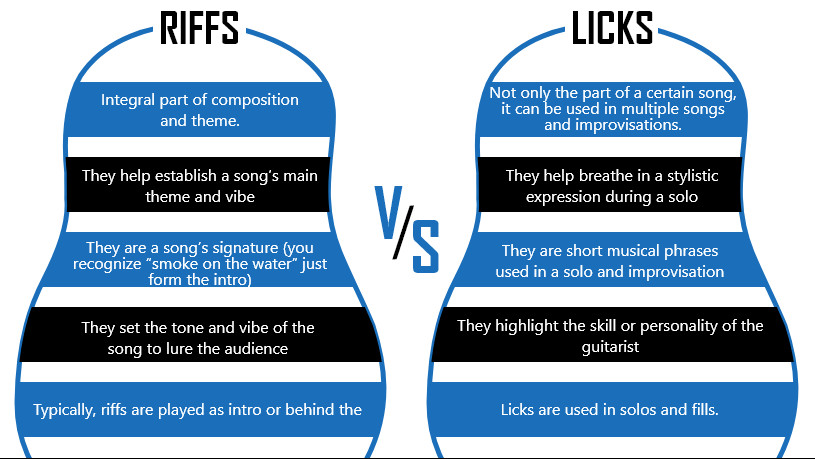 Infographic summarizing the key differences between guitar riffs and guitar licks using concise points and visual icons.
Infographic summarizing the key differences between guitar riffs and guitar licks using concise points and visual icons.
15 Must-Listen Iconic Guitar Riffs: Expand Your Musical Palette
Earlier, we introduced a few iconic riffs. Now, let’s expand that list with more exceptional examples that every guitarist should experience and draw inspiration from.
Some of these riffs are consistently ranked among the greatest guitar riffs of all time (picture_freelance, 2012), underscoring their significance in music history. Listening to these will provide invaluable insight into riff construction and impact.
Challenge yourself to imagine each song without its signature riff. This exercise will truly highlight the indispensable role riffs play in shaping a song’s identity and memorability. Grab your headphones, perhaps a pen and paper, and get ready to discover some essential additions to your musical playlist.
 A diverse group of guitarists playing electric guitars on stage, representing the global appeal of guitar riffs.
A diverse group of guitarists playing electric guitars on stage, representing the global appeal of guitar riffs.
Note: This list is presented in no particular order.
- “Brianstorm” – Arctic Monkeys (High-energy and angular modern rock riff)
- “Johnny B. Goode” – Chuck Berry (Rock and roll foundational riff, bluesy and upbeat)
- “Paranoid” – Black Sabbath (Heavy metal archetype, dark and ominous)
- “Sunshine of Your Love” – Cream (Psychedelic blues-rock with a distinctive, wah-infused riff)
- “One” – Metallica (Thrash metal epic with a powerful, progressive riff)
- “Back in Black” – AC/DC (Hailed as the greatest guitar riff of all time by NME – raw, energetic rock)
- “Pretty Vacant” – Sex Pistols (Punk rock anthem with a defiant, simple riff)
- “I Wanna Be Your Dog” – The Stooges (Proto-punk raw energy, repetitive and hypnotic riff)
- “I Can’t Explain” – The Who (Power pop precursor with a driving, melodic riff)
- “Cinnamon Girl” – Neil Young (Folk-rock simplicity with a warm, inviting riff)
- “Don’t Cry” – Guns N’ Roses (Ballad with a melancholic and emotionally charged riff)
- “Marquee Moon” – Television (Post-punk angularity, intricate and unconventional riff)
- “Get It On” – T. Rex (Glam rock stomper with a catchy, blues-infused riff)
- “Alive” – Pearl Jam (Grunge era anthem, powerful and anthemic riff)
- “Smells Like Teen Spirit” – Nirvana (Grunge revolution, iconic and instantly recognizable riff)
Beginner-Friendly Guitar Riffs to Practice at Home
Now, it’s your turn to pick up your guitar and put theory into practice! In this section, we’ll explore a selection of beginner-friendly guitar riffs that you can learn, practice, and personalize.
These riffs are designed to be accessible to players at any level, assuming you grasp basic guitar fundamentals. Whether you’re just starting out or have some experience, you should be able to play these riffs with practice and dedication.
As you practice, feel free to experiment with these riffs – incorporate them into your own songs or modify them to match your personal style. Riffs are meant to be springboards for creativity.
 A beginner guitarist practicing power chords on an electric guitar, focusing on hand position and technique.
A beginner guitarist practicing power chords on an electric guitar, focusing on hand position and technique.
Power Chord Guitar Riff for Beginners
This riff utilizes power chords and offers versatility for variations. It’s an excellent pattern for building riff-playing proficiency and can be integrated into your original songs, perhaps with minor adjustments to fit your composition. Palm muting enhances this riff’s impact. If you’re unfamiliar with palm muting, numerous online tutorials can guide you.
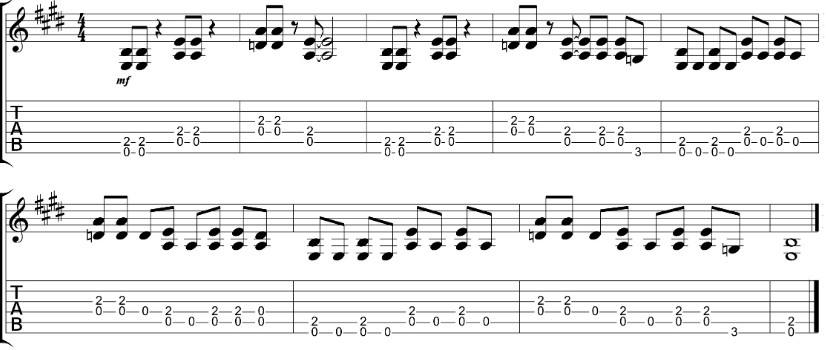 Guitar tablature for a power chord riff in E5, A5, and D5, visually representing the notes and rhythm.
Guitar tablature for a power chord riff in E5, A5, and D5, visually representing the notes and rhythm.
This riff uses E5, A5, and D5 power chords. Experiment with using this riff within a song’s chorus section, ensuring it complements the chorus’s overall feel and chord progression.
Funky Clean Guitar Riff for Rhythm Practice
Funky riffs are universally appealing! This riff offers a great introduction to funky rhythms. Like the previous example, feel free to modify this riff to create variations that suit your musical taste.
For this funky riff, try incorporating the neck-hand thumb technique. Using your thumb on your fretting hand offers convenient muting and rhythmic effects, adding to the funkiness. This riff is designed for repetition, making it ideal for song verses.
 Guitar tablature for a funky clean guitar riff, showcasing rhythmic notation and chord voicings.
Guitar tablature for a funky clean guitar riff, showcasing rhythmic notation and chord voicings.
Transpose this riff to G for subsequent bars to create variation. Utilize these riffs during verses and adapt them as needed throughout your song structure.
Acoustic Guitar Riff for Introduction
 A guitarist playing an acoustic guitar, demonstrating an acoustic guitar riff.
A guitarist playing an acoustic guitar, demonstrating an acoustic guitar riff.
Acoustic guitarists, we haven’t forgotten you! Acoustic guitars are equally capable of delivering compelling riffs.
Here’s an example of an excellent acoustic guitar riff for you to explore. Unlike the previous funky riff, this acoustic riff is designed for a single appearance in a song’s introduction. This concise yet effective riff sets the song’s tone and tempo immediately.
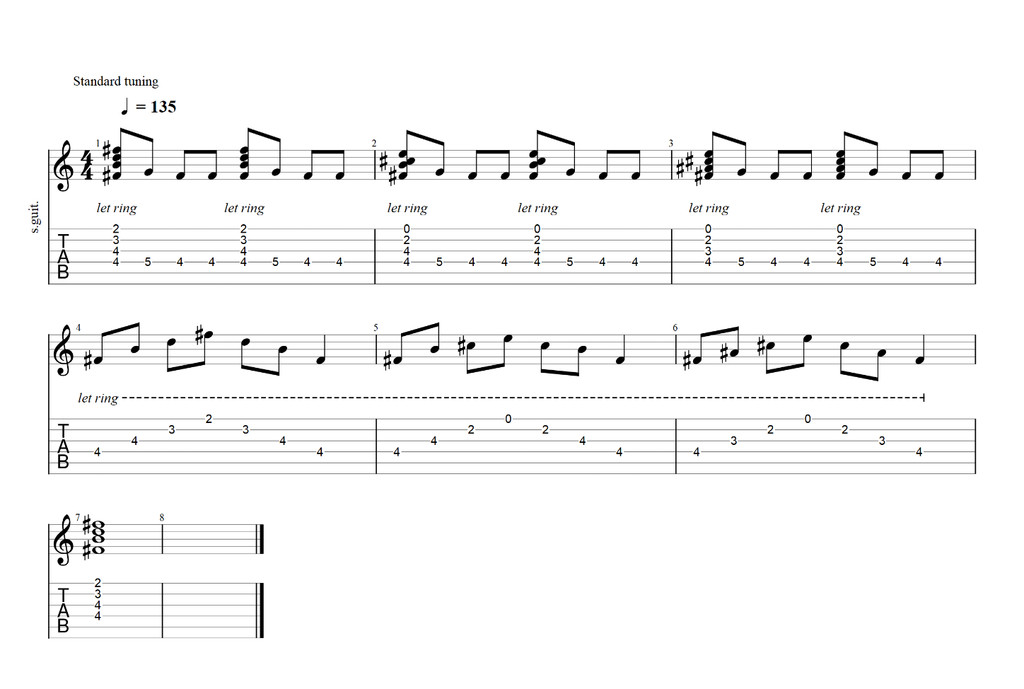 Guitar tablature for an acoustic guitar riff, showing fingerstyle or hybrid picking notation.
Guitar tablature for an acoustic guitar riff, showing fingerstyle or hybrid picking notation.
Guitar Licks to Experiment With at Home
Where there are riffs, licks are sure to follow! Let’s explore some guitar licks worth learning and practicing.
 A guitarist intensely focused on playing a fast guitar lick during a solo, showcasing passion and skill.
A guitarist intensely focused on playing a fast guitar lick during a solo, showcasing passion and skill.
Guitar Lick in the Style of Joe Satriani
When discussing guitar licks, Joe Satriani’s name frequently arises, and for good reason. He is widely regarded as one of the most technically proficient and musically innovative guitarists. His playing, execution, compositional style, and dynamic performances are inspiring and a fantastic style to emulate.
Here’s a lick inspired by Satriani’s work. It incorporates subtle techniques and slightly more advanced elements than the previous riff examples. Don’t be discouraged if it seems challenging initially—with dedicated practice, you’ll master it.
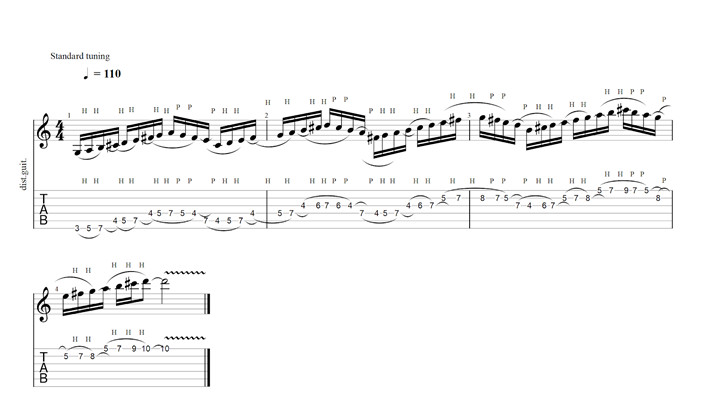 Guitar tablature for a guitar lick in the style of Joe Satriani, showcasing advanced techniques and fast phrasing.
Guitar tablature for a guitar lick in the style of Joe Satriani, showcasing advanced techniques and fast phrasing.
Guitar Lick in the Style of Wes Montgomery
Wes Montgomery, a true jazz guitar innovator! If you’re unfamiliar with his work, exploring Wes Montgomery is essential for any guitarist. To illustrate his genius, here’s a lick that mimics some of his signature techniques and improvisational flair. Montgomery’s thumb-picking style and melodic phrasing are instantly recognizable.
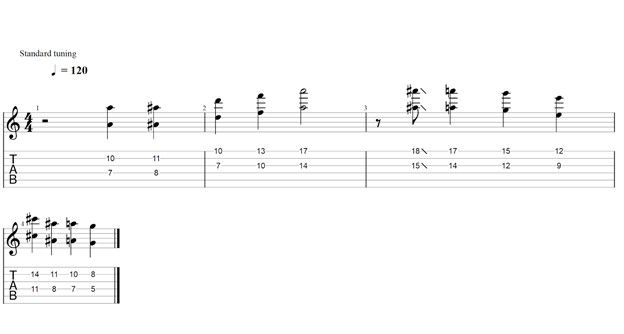 Guitar tablature for a jazz guitar lick in the style of Wes Montgomery, demonstrating thumb-picking and smooth jazz phrasing.
Guitar tablature for a jazz guitar lick in the style of Wes Montgomery, demonstrating thumb-picking and smooth jazz phrasing.
Concluding Thoughts: Riffs and Licks as Building Blocks
After experimenting with these tabs, you’re now better equipped to navigate the exciting world of guitar riffs and licks. They are fundamental building blocks for songwriting and guitar improvisation.
To further fuel your guitar journey, consider exploring resources that offer even more techniques, licks, and riffs.
For deeper learning, our book, “Soloing Techniques For Beginners,” is a valuable next step.
Packed with over 100 licks and riffs, many inspired by guitar legends, this book provides months of engaging practice material while enhancing your guitar skills.
Shop now and continue your path to guitar mastery!
[


